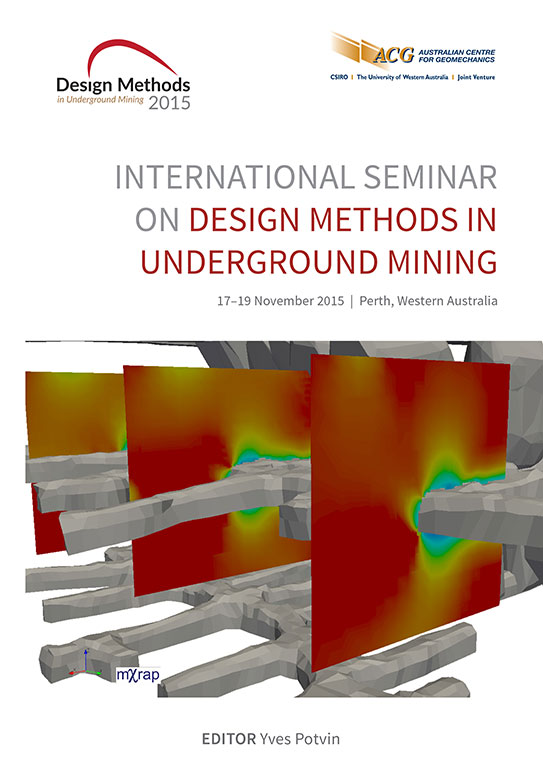Input to orepass design — a numerical modelling study

|
Authors: Sjöberg, J; Bolin, A; Sánchez Juncal, A; Wettainen, T; Mas Ivars, D; Perman, F |
DOI https://doi.org/10.36487/ACG_rep/1511_36_Sjoberg
Cite As:
Sjöberg, J, Bolin, A, Sánchez Juncal, A, Wettainen, T, Mas Ivars, D & Perman, F 2015, 'Input to orepass design — a numerical modelling study', in Y Potvin (ed.), Design Methods 2015: Proceedings of the International Seminar on Design Methods in Underground Mining, Australian Centre for Geomechanics, Perth, pp. 571-584, https://doi.org/10.36487/ACG_rep/1511_36_Sjoberg
Abstract:
Orepasses are an integral part of the mining infrastructure in sublevel caving. As part of the investigations for potential continued deeper mining in the LKAB Malmberget mine, a study on orepass design has been completed. The initial portion of the work involved numerical modelling and rock mass strength calibration of observed orepass fallouts, and spalling failure in a ventilation shaft. The calibrated numerical model was subsequently used to study different orientations and locations of orepasses for a potential haulage level at depth. The initial calibration work showed that a brittle material model — more precisely a cohesion-weakening frictionstrengthening (CWFS) model — was required to replicate both initiation and extension of stressinduced failure. A set of rock mass strength parameters was derived and further used in forward model prediction for planned orepasses. A large number of alternative scenarios were explored, in which orepass orientation and location, as well as material parameters, were varied. Orepass wear was simulated by creating a groove at the bottom of the orepass. Progressive spalling (stress-induced) failure was modelled in selected cases, by removing rock that was encapsulated by a contiguous shear band and the orepass wall in an iterative manner. The results are used in the design process for selecting suitable orepass locations.
References:
Hajiabdolmajid, V, Kaiser, PK & Martin, CD 2002, ‘Modelling brittle failure of rock’, International Journal of Rock Mechanics and Mining Sciences, vol. 18, no. 4, pp. 731-741.
Hajiabdolmajid, V, Kaiser, PK & Martin, CD 2003, ‘Mobilised strength components in brittle failure of rock’, Geotechnique, vol. 53, no. 3, pp. 327-336.
Hoek, E, Carranza-Torres, C & Corkum, B 2002, ‘Hoek-Brown failure criterion - 2002 edition’, Proceedings of the 5th North American Rock Mechanics Symposium and the 17th Tunnelling Association of Canada Conference (NARMS-TAC 2002), Mining and tunneling innovation and opportunity, University of Toronto, Toronto, ON, pp. 267-273.
Itasca Consulting Group, Inc. 2011, FLAC software, version 7.0, Itasca Consulting Group, Inc., Minneapolis, MN,
Martin, CD 1997, ‘Seventeenth Canadian Geotechnical Colloquium: The effect of cohesion loss and stress path on brittle rock strength’, Canadian Geotechnical Journal, vol. 34, no. 5, pp. 698-725.
Martin, CD, Kaiser, PK & McCreath, DR 1999, ‘Hoek–Brown parameters for predicting the depth of brittle failure around tunnels', Canadian Geotechnical Journal, vol. 36, no. 1, pp. 136-151.
Musa, AI, Basarir, H, Nordlund, E & Wettainen, T 2013, ‘The probabilistic estimation of rock masses properties in Malmberget mine, Sweden’, Electronic Journal of Geotechnical Engineering, vol. 18, pp. 269-387.
Perman, F 2013, 3D mine scale modeling of the Malmberget mine for the new main haulage level, report, no. 13-834E, prepared for LKAB, Luleå.
Sjöberg, J & Malmgren, L 2008, ‘Application of global-local modeling to mining rock mechanics problems’, Proceedings of the First International FLAC/DEM Symposium, Itasca Consulting Group, Inc., Minneapolis, MN, pp. 351-358.
© Copyright 2025, Australian Centre for Geomechanics (ACG), The University of Western Australia. All rights reserved.
View copyright/legal information
Please direct any queries or error reports to repository-acg@uwa.edu.au
View copyright/legal information
Please direct any queries or error reports to repository-acg@uwa.edu.au